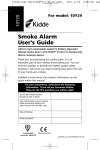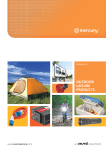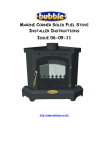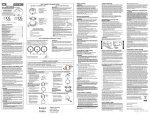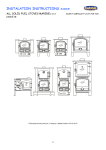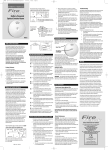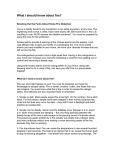Download Smoke Detector Manual (SSSD1)
Transcript
Smoke Detector Manual (SSSD1) Introduction Recommended locations (single sleeping area) The SimpliSafe Smoke Detector (SSSD1) is a photoelectric smoke detector, designed to sense smoke that comes into the detector chamber. It does not sense gas, heat, or flame. This smoke detector is designed to give early warning of developing fires with an alarm sound from its built-in siren. The built-in wireless transmitter can also cause your SimpliSafe Base Station siren to sound. These sirens can provide precious time to escape before a fire spreads. However, the smoke detector makes such pre-warning of fire possible only if the smoke detector is located, installed, and maintained properly as described in this User's Manual. The smoke detector also monitors low battery and sensor malfunction. These trouble conditions will cause an audible chirp from the smoke detector as described in the “Operating Modes” section below. Recommended locations (multiple sleeping areas) Smoke Detector Location Smoke detectors should be installed in accordance with the National Fire Protection Association (NFPA) Standard. NFPA Standard 72, Section 2-4: “2-4.1.1 Smoke detectors shall be installed outside of each separate sleeping area in the immediate vicinity of the bedrooms and on each additional story of the family living unit including basements and excluding crawl spaces and unfinished attics. Recommended locations (multi-floor residence) The provisions of 2-4.1.1 represent the minimum number of alarms required by this standard. It is recommended that the householder consider the use of additional smoke detectors for increased protection for those areas separated by a door from the areas protected by the required smoke detectors under 24.1.1 above. The recommended additional areas are living room, dining room, bedroom(s), kitchen, attic (finished or unfinished), furnace rooms, utility room, basement, integral or attached garage, and hallways not included in 2-4.1.1 above. However, the use of additional alarms remains the option of the householder.” WARNING: The Smoke Detector is intended for residential use only and is not to be used in a commercial application. Install the sensor in the center of the ceiling CAUTION (as required by the California State Fire Marshall) “Early warning fire” detection is best achieved by the installation of fire detection equipment in all rooms and areas of the household as follows: (1) A smoke detector installed in each separate sleeping area (in the vicinity, but outside of the bedrooms), and (2) Heat or smoke detectors in the living rooms, dining rooms, bedrooms, kitchens, hallways, attics, furnace rooms, closets, utility and, storage rooms, basements and attached garages.” SimpliSafe Smoke Detector Owner’s Manual Issue # SSSD1-A 1/5 December 2012 Suggested smoke detector locations: WARNING: Never remove the battery from the smoke detector to stop a nuisance alarm. Open a window or fan the air around the smoke detector to get rid of the smoke. The detector will turn itself off when the smoke is gone. If nuisance alarms persist, attempt to clean the smoke detector as described in this User’s Manual, or relocate it to a better location. • In the hallway outside each bedroom area. • On every floor of a multi-floor home or apartment and a minimum of two detectors in any household. • At both ends of a bedroom hallway if the hallway is more than 40 feet long. WARNING: Do not stand close to the smoke detector when the alarm is sounding. The alarm is loud in order to wake you in an emergency. Too much exposure to the horn at close range may be harmful to your hearing. • At the bottom of a basement stairwell. • At the top of a first-to-second floor stairwell. • As close to the center of the ceiling as possible. If this is not practical, put the detector on the ceiling, no closer than 4 inches (10 cm) from any wall or corner. For sloped ceilings, mount detector 3 feet measured horizontally from the highest point of the ceiling. If ceiling mounting is not possible and wall mounting is permitted by your local and state codes, mount the detector high on the wall (about 4 and 6 inches from the ceiling). Installing the Smoke Detector Install the Smoke Detector on a ceiling or wall: Locations to avoid To avoid false alarms and optimize detection of real alarms, do not install a smoke detector: 1. Remove the mounting bracket from your unit by rotating it counterclockwise. 2. Mount the bracket on the ceiling or wall, using the included screws and wall anchors. 3. Push the Smoke Detector onto the mounting bracket and turn it clockwise until it clicks into place. Pull outward on the detector to make sure it is securely attached. NOTE: After you install the smoke detector and whenever you change its battery, you must test it according to the instructions below to make sure it is functioning correctly. • In locations where combustion particles may normally be present, such as kitchens with few windows or poor ventilation, garages where there may be vehicle exhaust, near furnaces, hot water heaters, and space heaters. We recommend leaving at least 20 feet between the detector and such locations. Test / Silence Button & Power / Smoke Alarm LED indicator • In damp or very humid areas, or near bathrooms with showers. Moisture in humid air can enter the sensing chamber, and cause a false alarm. Install the smoke detector at least 10 feet away from bathrooms. Mounting bracket • In very cold or very hot areas. If the temperature goes above or below the sensors operating range, it will not work properly. • In very dusty or dirty areas. Dirt and dust can build up on the sensing chamber, making it overly sensitive, or block openings to the sensing chamber, making it less sensitive. WARNING: Do not connect smoke detectors to any other alarm or auxiliary device. Connecting anything else to this detector will keep it from working properly. • Near fresh air vents or very drafty areas like air conditioners. Heaters or fans, fresh air vents and drafts can drive smoke away from smoke detectors. CAUTION: This smoke detector comes with cover latches that will prevent the smoke detector cover from closing if battery is not installed. This tells you that the smoke detector will not work until a new battery is properly installed. • In a dead air space at the top of a peaked roof, or in the corners between ceilings and walls. Dead air may prevent smoke from reaching a detector. • In insect-infested areas. If insects enter the sensing chamber, they may cause a nuisance alarm. Where bugs are a problem, get rid of them before putting up an detector. Battery Installation • Near fluorescent lights. Electrical “noise” from fluorescent lights may cause nuisance alarms. Install smoke detectors at least 5 feet (1.5 meters) from such lights. 2. Install a new Panasonic CR123A 3V lithium battery, making sure the + and - ends of the battery are aligned properly. 1. Open the battery compartment 3. After the battery is installed and the smoke detector is mounted on its bracket, you will hear a chirp which indicates the unit is receiving battery power. • Make sure no door or other obstruction blocks the path of smoke to the detector. NOTE: Use only a Panasonic CR123A battery. This smoke detector may not operate properly with other kind of battery. IMPORTANT: You should never disable the unit to avoid nuisance alarms. Instead, relocate the detector to a better location. SimpliSafe Smoke Detector Owner’s Manual (Revision # SSSD1-A) 2/5 December 2012 Testing Maintenance tips Test your smoke detector weekly by pressing the test button (the clear button on the front of the sensor) for 4 seconds. The sensor’s siren will sound (3 beeps, pause, 3 beeps) and the light will flash continuously and rapidly. If this sensor is enrolled in a SimpliSafe alarm system, the base station will also sound during this test. To keep your detector in good working order open the cover and vacuum the dust off the sensing chamber at least once a month. • Remove the battery before cleaning. • Use soft brush attachment on your vacuum to carefully remove any dust, especially on the openings of the sensing chamber. Never use water or cleaners. If the smoke detector beeps three times with the yellow LED flashing three times in 43 secs, it indicates the smoke detector is not working properly - it must be repaired or replaced. • Replace the battery after cleaning. Test the smoke detector to make sure battery is working correctly. This is the only way to make sure that the smoke detector unit is working properly. If the unit fails to test properly, have it repaired or replaced immediately. Caution: Continuous exposure to the high sound level of this alarm over an extended period of time may cause hearing loss. WARNING: Never use an open flame of any kind to test your detector. You may damage it as well as your home. The built-in test switch accurately tests all functions as required by Underwriters’ Laboratories. WARNING: When you are not testing the unit and the alarm siren sounds, the detector is a warning of a possible serious situation, which requires your immediate attention. LIMITATIONS OF SMOKE DETECTORS Wireless smoke detectors are very reliable, but may not work under all conditions. No fire alarm provides total protection of life or property. Alarms are not a substitute for insurance. Go/No-Go Field Test: Please use Home Safeguard Model 25S UL Listed aerosol smoke detector tester, following the instructions listed on the canister. Smoke detectors require a source of power to work. This smoke detector will not operate and the alarm will not sound if batteries are dead or not installed properly. Silence Feature Smoke detectors may not be heard. A sound sleeper or someone who has taken drugs or alcohol may not awaken if the detector is installed outside a bedroom. Closed or partially closed doors and distance can block sound. This detector is not designed for the hearing impaired. Press the “test/silence” button (the clear button on the front of the detector) to temporarily quiet an alarm for up to 10 minutes. If smoke is still present around the smoke detector after 10 minutes of silence, the unit will re-alarm. Smoke detectors may not always activate and provide warning early enough. A smoke detector only activates when enough smoke reaches it. If a fire starts in a chimney, wall, roof, on the other side of closed doors, or a different level of the property not enough smoke may reach the detector. Operating Modes The LED light on the front of the sensor indicates the operating mode of the smoke detector: Red LED blinks 3 times rapidly: The detector has sensed a potentially dangerous level of smoke. The buzzer and alarm siren will also sound. Please follow the "in case of fire" instructions. Smoke detectors are a significant help in reducing loss, injury and even death. However, no matter how good a detection device is, nothing works perfectly under every circumstance and we must warn you that you cannot expect a smoke detector to ensure that you will never suffer any damage or injury. Red LED blinks about once per minute: your detector is functioning normally. Red LED blinks AND chirps once per minute: the Smoke Detector battery is low. This low battery warning signal should last for up to 30 days, but you should install a new Panasonic CR123A 3V lithium battery immediately. Fire prevention and escape The purpose of an early warning smoke detector is to detect the presence of fire in its early stages and sound an alarm giving the occupants time to exit the premises safely. Yellow LED blinks three times per minute: this indicates the unit has malfunctioned and needs to be replaced. Avoid fire hazards Yellow LED blinks three times and chirps 3 times every 30 seconds: this indicates that the unit is no longer operating within its intended sensitivity and must be replaced. • Do not smoke in bed. • Do not leave children home alone. • Never clean with flammable liquids such as gasoline. SimpliSafe Smoke Detector Owner’s Manual (Revision # SSSD1-A) 3/5 December 2012 WARNING: This device contains a wireless transmitter that can • Properly store materials. Use general good housekeeping techniques to keep your home neat and tidy. A cluttered basement, attic, or storage area is an open invitation to fire. actuate a remote audible siren. When used in a typical single level or multilevel dwelling, or in apartment buildings where adjacent apartments may have similar systems, it is possible that interference for another system could prohibit the remote siren from sounding in the event of an alarm. Never rely solely on the remote siren for notification of an alarm. Always make sure that the internal siren in the Smoke Detector can be heard from all bedrooms and living areas. • Use combustible materials and electrical appliances carefully and only for intended uses. Do not overload electrical outlets. • Do not store explosive and/or fast burning materials in your home. • Even after proper precautions have been taken, fires can start. Be prepared. Specifications In case of fire Required batteries Panasonic CR123A 3V lithium battery Sensor Photoelectric • Leave immediately. Don’t stop to pack or search for valuables. Audible alarm Over 85dB at 3m temporal pattern Sensitivity Per UL217 and EN14604 standards • In heavy smoke, hold your breath and stay low, crawl if necessary. The clearest air is usually near the floor. Dimensions 12cm diameter x 5.3cm depth Operating environment Temperature Relative humidity 40 to 100°F (4.4 to 37.8°C) 10 to 95% non-condensing In the event of a fire, you should do the following: • If you have to go through a closed door, carefully feel the door and door knob to see if undue heat is present. If they seem cool, brace your foot against the bottom of the door with your hip against the door and one hand against the top edge. Open it slightly. If a rush of hot air is felt, slam the door quickly and latch it. Unvented fire tends to build up considerable pressure. Be sure all members of the household realizes and understands this danger. ETL Rating The Smoke Detector Conforms to UL Standard 268. FCC Part 15 Notice • Use your neighbor’s phone or a street fire alarm box to call the fire department. The job of extinguishing the fire should be left to the professionals Be prepared This device complies with part 15 of the FCC Rules. Operation is subject to the following two conditions: (1) This device may not cause harmful interference, and (2) this device must accept any interference received, including interference that may cause undesired operation. Practice the following steps to prepare you and your family in the event of a fire: Warning: Changes or modifications to this unit not expressly approved by the party responsible for compliance could void the user's authority to operate the equipment. • Perform fire drills regularly. Use them to assure recognition of an alarm signal. NOTE: This equipment has been tested and found to comply with the limits for a Class B digital device, pursuant to Part 15 of the FCC Rules. These limits are designed to provide reasonable protection against harmful interference in a residential installation. This equipment generates, uses, and can radiate radio frequency energy and, if not installed and used in accordance with the instructions, may cause harmful interference to radio communications. However, there is no guarantee that interference will not occur in a particular installation. If this equipment does cause harmful interference to radio or television reception, which can be determined by turning the equipment off and on, the user is encouraged to try to correct the interference by one or more of the following measures: • Draw a floor plan and show two exits from each room. It is important that children be instructed carefully, because they tend to hide in times of crisis. • Establish one meeting place outside the home. Insist that everyone meet there during an alarm. This will eliminate the tragedy of someone reentering the house for a missing member who is actually safe. - Reorient or relocate the receiving antenna. • If you have children and/or physically challenged people residing in your household, use window decals to help emergency personnel identify the sleeping quarters of these individuals. - Increase the separation between the equipment and receiver. - Connect the equipment into an outlet on a circuit different from that to which the receiver is connected. - Consult the dealer or an experienced radio TV technician for help. WARNING!! Smoke detectors CANNOT provide warnings for fires resulting from explosions, smoking in bed or other furniture, ignition of flammable liquids, vapors and gases, children playing with matches or lighters. Customer support For any questions regarding your Detector, please contact: SimpliSafe, Inc 1035 Cambridge St, 18A Cambridge, MA 02141 Email: [email protected] Website: www.simplisafe.com, Phone: 1-888-957-4675 WARNING: Smoke detectors are not to be used with detector guards unless the combination has been evaluated and found suitable for that purpose. SimpliSafe Smoke Detector Owner’s Manual (Revision # SSSD1-A) 4/5 December 2012 SimpliSafe Smoke Detector Owner’s Manual (Revision # SSSD1-A) 5/5 December 2012






